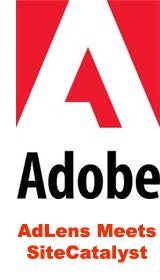 Adobe has integrated two of its core digital marketing products – SiteCatalyst and AdLens (formerly Efficient Frontier).
Adobe has integrated two of its core digital marketing products – SiteCatalyst and AdLens (formerly Efficient Frontier).
The integration will let advertisers take granular data out of SiteCatalyst and plug it into AdLens for use in search, social, and display ad campaign optimization. Data such as shopping cart abandonment and time on site can be used to enhance campaigns in all three channels, Adobe says.
Additionally, the company has tightened the integration between AdLens and its Audience Manager data management platform, which is based on technology bought via its DemDex acquisition. This will allow clients to more easily plug first and third party data into inventory sourced on a range of supply sources, including DoubleClick Exchange, Right Media, Rubicon, and PubMatic.
The overall effect for marketers is “much richer data sets to be used across search display and social advertising,” says Justin Merickel, an Adobe exec with oversight of ad product innovation. Perhaps more to the point, the product assimilation does away with manual integration processes and cumbersome data feeds, he says.
The integration move is reminiscent of Google’s Doubleclick Digital Marketing rollout last spring (AdExchanger story), which finally began to break down the walls between a range of display ad platforms within the Google stack including DoubleClick ad serving, the DoubleClick Exchange, Invite Media/DoubleClick Bid Manager, and other technologies.
There are a number of important differences as well, including Adobe’s proud media agnosticism. “We are not a primary player in media,” Merickel says. “Google makes their money on search and display and on media inventory. That’s not what Adobe does. We want to be an independent partner for our clients.”
Adobe is increasingly focused on Facebook as well, and it was named to Facebook’s new class of Strategic Preferred Marketing Developers last month. The strategic PMD program allows Facebook to call out exemplary third parties in its ecosystem with superior technologies, excellent results, or a global client base.
We asked Merickel about Adobe’s value proposition on Facebook, in particular with regard to the Facebook Exchange. Here’s what he had to say:
“It’s a unique and high quality inventory source that our clients show strong demand for as a whole. Facebook has a ton of potential in looking at how do you tie engagement into the framework you’re using for success. One of the ties we work to leverage at Adobe is that seamless integration between content and advertising. We haven’t worked out how that plays into the Facebook Exchange, but certainly the more we drive engagement on Facebook, the more success we see in advertising looking at the proliferation of Recommended and Sponsored Stories.
While the framework is different [with Facebook Exchange], the inventory is similar and the broad goals clients have with Facebook are similar as well. I still think the goal of social advertising will be similar and the idea of leveraging the engagement of the brand will be critical to the success of the overall social programs.
A lot of the players today are pure DSPs and don’t have access to the biddable markets. They can’t run things like Sponsored Stories. We’re looking at the full spectrum.”













